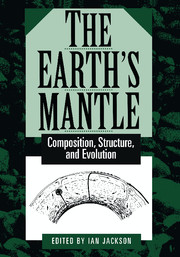Book contents
- Frontmatter
- Contents
- Chapter Outlines
- Contributors
- Dedication
- Preface
- I Accretion and Differentiation of the Earth
- II Dynamics and Evolution of the Earth's Mantle
- III Structure and Mechanical Behaviour of the Modern Mantle
- 8 Seismic Structure of the Mantle: From Subduction Zone to Craton
- 9 Composition and Temperature of the Earth's Mantle: Seismological Models Interpreted through Experimental Studies of Earth Materials
- 10 The Viscosity of the Mantle: Evidence from Analyses of Glacial-Rebound Phenomena
- 11 Mantle Rheology: Insights from Laboratory Studies of Deformation and Phase Transition
- Index
11 - Mantle Rheology: Insights from Laboratory Studies of Deformation and Phase Transition
Published online by Cambridge University Press: 23 November 2009
- Frontmatter
- Contents
- Chapter Outlines
- Contributors
- Dedication
- Preface
- I Accretion and Differentiation of the Earth
- II Dynamics and Evolution of the Earth's Mantle
- III Structure and Mechanical Behaviour of the Modern Mantle
- 8 Seismic Structure of the Mantle: From Subduction Zone to Craton
- 9 Composition and Temperature of the Earth's Mantle: Seismological Models Interpreted through Experimental Studies of Earth Materials
- 10 The Viscosity of the Mantle: Evidence from Analyses of Glacial-Rebound Phenomena
- 11 Mantle Rheology: Insights from Laboratory Studies of Deformation and Phase Transition
- Index
Summary
The deformation of Earth materials is not fundamentally different from that of man-made polycrystalline, polyphase solids, such as metals, alloys, and ceramics. We already have extensive bodies of knowledge concerning fracture and flow in such materials in general, and that information should be reviewed briefly before we proceed to discuss the rheology of rocks. The discussion of mechanical behaviour at elevated temperature and pressure inside the Earth will be divided into two parts: processes in the upper mantle, and processes in the deep mantle (involving the transition zone and the lower mantle). We shall follow the terminology of Ringwood (1975) for the subdivisions of the Earth's mantle (Jackson and Rigden, Chapter 9, this volume). Later sections will review phase transformations in the Earth and the possible mechanical consequences, and a final section will briefly address future developments.
General Introduction to Deformation of Crystalline Solids
A solid material subjected to stress that exceeds its elastic limit will become permanently deformed or strained, and the accumulation of the increments of strain is time-dependent. The term ‘plastic’ denotes the nonelastic part of the strain that is not recovered following the removal of the applied stress. In general, to analyze or predict the elastic and plastic responses of any stressed solid, one must know not only the state of stress but also the environmental conditions and the nature of the solid.
If a material deforms in a brittle manner, the permanent strain field is discontinuous.
- Type
- Chapter
- Information
- The Earth's MantleComposition, Structure, and Evolution, pp. 503 - 560Publisher: Cambridge University PressPrint publication year: 1998
- 3
- Cited by



